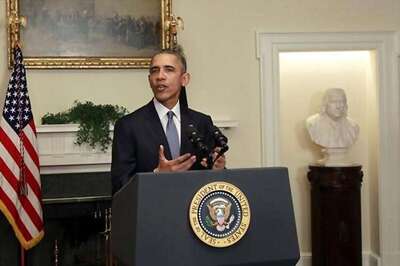
views
Boeing Co will pay a $6.6 million to US regulators as part of a settlement over quality and safety-oversight lapses going back years, a setback that comes as Boeing wrestles with repairs to flawed 787 Dreamliner jets that could dwarf the cost of the federal penalty.
Boeing is beginning painstaking repairs and forensic inspections to fix structural integrity flaws embedded deep inside at least 88 parked 787s built over the last year or so, a third industry source said.
The inspections and retrofits could take weeks or even up to a month per plane and are likely to cost hundreds of millions – if not billions – of dollars, depending to a large degree on the number of planes and defects involved, the person said.
The Federal Aviation Administration said Boeing had agreed to pay $6.6 million in penalties after the aviation regulator said it failed to comply with a 2015 safety agreement.
The penalties include $5.4 million for not complying with the agreement in which Boeing pledged to change its internal processes to improve and prioritize regulatory compliance and $1.21 million to settle two pending FAA enforcement cases.
“Boeing failed to meet all of its obligations under the settlement agreement, and the FAA is holding Boeing accountable by imposing additional penalties,” FAA Administrator Steve Dickson said in a statement. Boeing, which paid $12 million in 2015 as part of the settlement, did not immediately comment.
Boeing engineers are working to determine the scope of inspections, including whether jets can be used as-is without a threat to safety, two people said. Boeing has not told airlines how many jets are impacted, another person said.
The FAA has been investigating instances of oversight lapses, debris left inside finished aircraft, and managers putting pressure on employees handling safety checks for the FAA, people familiar with the proceedings said.
For example, in August 2020, Boeing told to the FAA about the flaw involving structural wrinkling in the interior fuselage skin where carbon-composite barrels that form the plane’s lightweight body are melded together.
But the defect went unnoticed for months or longer because computerized safeguards that crunch data looking for quality flaws had not been programmed to look for the gaps, a third industry source said.
DELIVERY TARGET
The 787 production problems have halted deliveries of the jet since the end of October, locking up a source of desperately needed cash for Boeing.
The fuel-efficient 787 has been a huge success with airlines, which have ordered 1,882 of the advanced twin-aisle jet worth nearly $150 billion (74.7 billion pounds) at list prices.
But the advanced production process and sprawling global supply chain caused problems over the years.
As of February, Boeing had fixed the 787 production process causing the wrinkling defect, according to two people familiar with the matter.
However, planes rolled off the assembly line with the flaw for more than a year, at least, continuing even after the flaw was discovered in August 2020.
“It’s difficult to see a definitive fix that is agreeable by the aviation authorities and all going forward,” Boeing customer Air Lease Corp’s CEO John Plueger told analysts on an earnings call Feb 22. “I don’t think that we’re there yet.”
Boeing has been working on the fuselage problem, and two additional potentially hazardous defects that arose since 2019, as it charted plans to consolidate final assembly of the 787 in South Carolina starting next month, at a sharply reduced rate of 5 787s per month.
One senior supply chain source said they will have to cut rate again.
Boeing said last month it expects to resume handing over a small number of 787s to customers later this quarter.
It has an ambitious internal plan to deliver 100 of the jets this year, one person said. Analysts say deliveries are not expected to recover to 2019 levels until at least 2024.
‘OPEN-HEART SURGERY’
But before any jet is delivered, it must go through invasive inspections and costly repairs.
First, technicians must pull out the passenger seats, open up the floor paneling and use specialty tools to measure whether defects invisible to the naked eye are present, according to three people with direct knowledge of the process.
The repair work – already underway at Boeing factories in Everett, Washington and North Charleston, South Carolina – is even harder.
In the bowels of the jet, technicians have to remove multiple specialty fasteners on both sides of the inner fuselage skin, then install newly produced “shims” that fill out gaps and remove the structural dimpling. Workers then replace all the fasteners, re-paint, and re-install the interior, they said.
“It’s like open heart surgery,” one of the people said. “They’ll be retrofitting the fleet for potentially several years.”
Read all the Latest News, Breaking News and Coronavirus News here




















Comments
0 comment